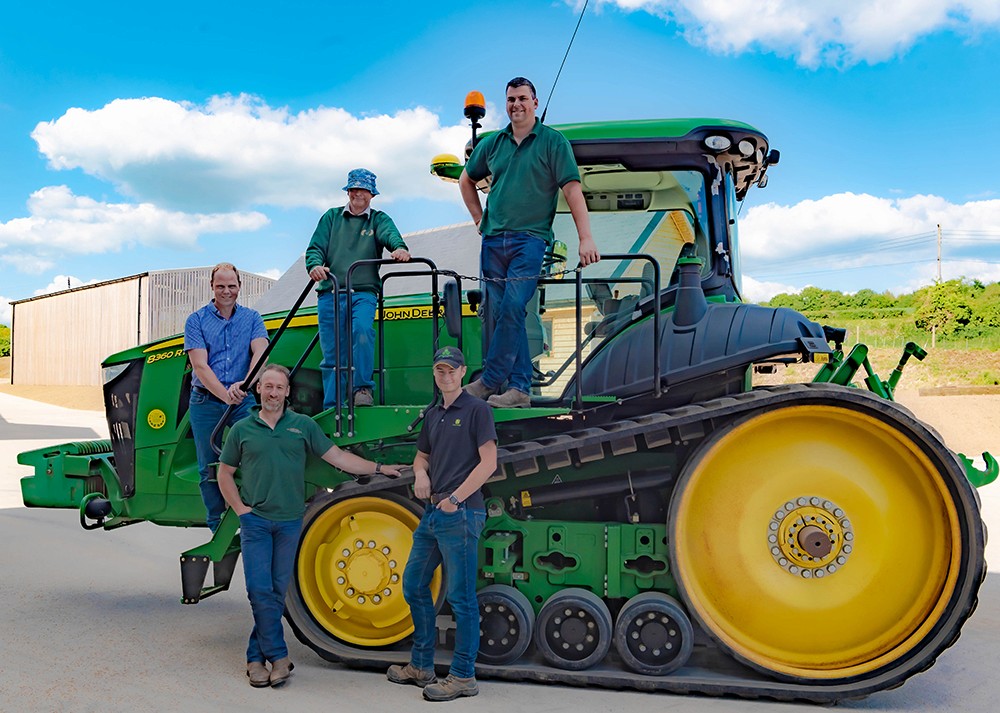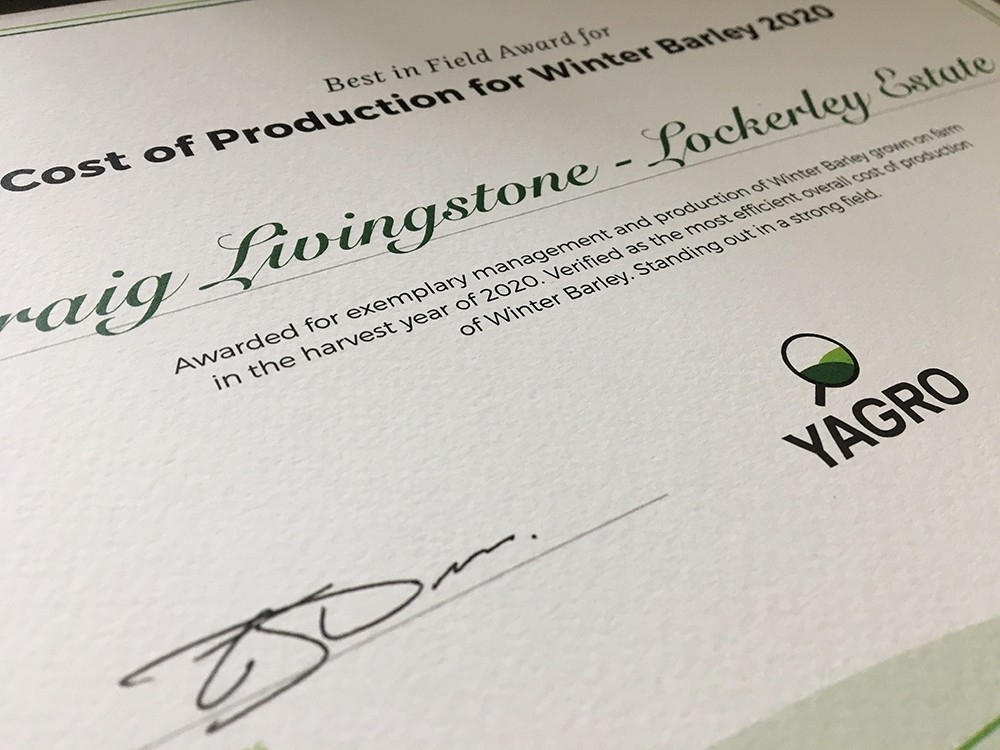Lockerley Estate has the best Cost of Production for Winter Barley
DAN JOLLY
Lockerley Estate have been credited with having the best cost of production for their Winter Barley at £39.93 per tonne. We spoke to Craig Livingstone to find out more about how they achieved this and hear a little about their future plans.

Tell us a bit about yourself.
I came into agriculture a slightly different way. My mother's family are farmers, but both my parents were police officers. Since a young age I have always been on the farm, so I decided to study agriculture at SAC Edinburgh. I was a farm operator in Oxfordshire before becoming an agronomist for five years near Newbury, eventually coming here to Lockerley five years ago.
Tell us about the farm.
Lockerley Estate is owned by three siblings of the Sainsbury family, which comprises 800ha of arable crops. We have an ambitious higher tier project that will enable us to continue producing food and answering the carbon, soil, biodiversity, and other questions currently asked of farmers.
Alongside the arable farming, we graze 1,300 sheep in partnership with a local Shepherd, and we have a small herd of English Longhorn cattle on a rewilding project next to our SSSI and SAC. We supply vegetables from our new enterprise direct to local shops and farm gate along with eggs, venison and Lockerley flour.
What soil type are you working with?
We have 11 different soil types on the farm, ranging from heavy clay, lots of flint to light chalk. We use precision farming techniques, variable seed rates and variable P & K, etc to help cope with the varying soils. We'd sort of fit into that regenerative agriculture bracket in terms of our ethos, and for the last five years we've had some firm objectives of how we want to farm. Our pesticide spend has significantly reduced due to changes in the rotation and taking decision making in-house. Our fertiliser spend has also decreased, which has been enabled by the use of organic fertiliser, cover crops and livestock In the arable rotation.
You have been identified as the Best in Field for having the best cost of production for Winter Barley. Can you tell us a bit more about your Winter Barley in general?
Winter Barley facilitates practical and logistical advantages within the rotation such as cover crop establishment, FYM applications, lime and baling etc. The harvest window is open earlier, so we're able to concentrate on higher-value crops such as Peas, Milling Wheats and Spring Malting Barley when the time is right. A Winter Malting variety, like our Craft, with good agronomical scores, require less nitrogen and also works towards lower inputs and helps facilitate our goal of being net-zero on the farm, as well as being cheaper to grow.
Your Winter Barley had a cost of production of £39.93 per tonne, which you seem to have consistently reduced over the past three years, down from nearly £60 per tonne in 2018. Part of this is in yields increasing but also reducing your costs. Could you shed some light on how you've achieved this?
Last year our Winter Barley was good; it has been getting better and better, and a lot of that has come from making small corrections. Last year it was grown on the nice chalk, which enabled us to drill it in good time, and it gave us good yields of 9.58t/ha. This isn't always the case, but last season worked well.
I am a big believer in a profitable rotation and not just profitable crops. For example, we grow Spring Beans here, which are difficult to justify on an individual crop basis, however, when you link it to our goal of being carbon neutral, it solves many of the issues we're trying to counter, such as soil degradation. So, as long as Winter Barley continues to contribute and offer wider advantages, it will keep its place. We have resistant flea beetle here, so we can't grow OSR. The rotation is like a big game of chess as to why we're doing certain things, and higher tier options now form a bigger part on land that wasn’t contributing consistently. Our cost of production has been reduced by a combination of our techniques and decision making on farm.
Do you have a set rotation on-farm?
We have a skeletal rotation, so in principle we know what is going where, but we are reactive to what is needed. As much as we want to remain practical and efficient with equipment, the "regenerative" farming techniques have meant a little more flexibility in the system, enabling us to make the most of cover crops, grazing window and spreading FYM or fibrophos, for example.
Your seed cost was £81.95/ha, which is broadly in-line with other growers in our system. However, it was applied 16% higher than our median. You must be buying your seed well? And why the higher than average seed rate? It was drilled in October, so not too late in the season?
It's all to do with our soil types. The variable seed application rate per m2 is adjusted for the establishment percentage and the soil type. We consider everything from drilling dates to tillering ability and lodging risk etc., and that lands us at an appropriate number. We have a good relationship with Agrii, so our seed is either home saved through their mobile plant or purchased fresh stock. We test all seed now pre-cleaning, which gives us the confidence needed to reduce seed dressings.
Are Agrii your sole supplier? Your prices are sharp, do you shop around?
They are our primary supplier. We also deal with Cotswold Seed for our conservation needs, and I usually buy fertiliser through ADM. Pesticides would come from Agrii, and they stand by us very well. We do benchmark with YAGRO, so all suppliers have to perform, which they do. We get fantastic service from them, and I couldn't grumble at all.
Does Agrii also provide the agronomy on farm?
I do all the crop walking, and our sprayer operator is also BASIS qualified. I am a member of NIAB TAG and do have strategic advice. We take levels of risk that I wouldn't have been willing to take in the past when I was an agronomist. Our capacity allows us to be reactive if needed, and we accept this risk, but we won't accept spending money on pesticides simply for insurance, because it's expensive! We try and remain as prescriptive as is sensible.
Your fertiliser cost was £144.64/ha, which is one of the lowest in the system for Winter Barley. How have you achieved this?
We are trying to wean ourselves off red diesel and nitrogen fertiliser, otherwise we will never get our system to operation zero, which is a business objective. Testing shows that nitrogen use efficiency is poor on the chalk, so our product choice is vital. Timing is critical on Winter Malting Barley to promote active tillering early and keep grain N low. This is why we don't grow feed or hybrid Barley, as the inputs required don't fit with our system.
Your chemistry application is very lean across all categories. How are you keeping the rates so low?
Due to Craft being a malting crop, there was no pre-harvest roundup used, and the only Glyphosate we use is the amount required to control the problem. As with all pesticides, we plan to use as little as possible especially with any soil contact, but enough to do the job. Last season we had 1.2mm rain in May, so the crop was clean. We, therefore, didn't need the growth regulators and fungicides that may have been required in a different season. We must remain reactive to what the season dictates. The variety, drilling date and other factors all play a part in decisions on use of inputs.
Tell us a bit more about Craft. Will you be sticking with this variety next year?
We won't, actually. We've changed to Maris Otter mainly because of delivering net-zero carbon - Maris Otter requires an extremely low Nitrogen input. We're currently working with a partner where our Barley will come back to us as a product, so we need to be part of the whole value chain, not just producing commodities. Although I anticipate a slightly higher fungicide spend on Maris Otter, there will be a significant reduction in fertiliser. So, for me, it's a double win as we get the bonus of a Winter Barley crop, and we're also answering some carbon questions in the process.
You're a very carbon conscious farm. Are you part of any Stewardship schemes or ELMS?
Yes, we are involved in three ELMS testing trials. We are LEAF mark certified, which I am very proud of, and we're a LEAF demonstration farm. We've got a significant higher tier application for 2020, and we're already in the mid-tier scheme, which will combine our woodland and the two SSSI.
Who do you credit with helping you with achieving these awards?
It's been an enormous team effort. The landowners give us confidence and enable us to think as we do. We're a small team of five, and everybody plays their part, whether it's walking the crops, planting crops, store management and everything in between; everyone plays a significant role.
We work closely with Robin Appel Grain Merchants for marketing our Winter and Spring Barley. With 11 different soil types at Lockerley, it can be challenging to provide consistency with final grain nitrogen quality, so a strong relationship with Jonathan and his team has really helped in recent years. Just about everything that leaves the farm gate goes at a premium, and that's due to changing practices and our in-hand decision making. We try never miss an opportunity and control as much as we possibly can. Wider relationships with strategic agronomy advice/grain marketing/ suppliers/ hauliers etc., all add to the wider team. The more honest we have been with ourselves about the farm's abilities and challenges, the more consistent we have become.
What do you have planned for this harvest year (2021)?
A lot of the changes have been made, such as the rotation. There will be no OSR, but there will be a significant increase in pulses, so peas and beans, clover grass leys, legume fallow mixtures etc.
As I’ve said, going forward the higher tier stewardship will be a crucial change. This year we've been using the zero-till drill for the first time after five years of soil preparation, which has been great. This is in combination with our min-till system, and as we learn more and develop our confidence, we will expand the acreage covered. Just keep trying to do the basics right and don't make life overly complicated!
Looking beyond this year, what are your plans for farming in the coming years, and how will you adapt to farming post BPS?
We've been preparing for the loss of BPS for the last few years in line with industry commentary. We are continuing to have firm control of our numbers, and we plot our risk a bit like a pension. So, we look at which crops are our high risk - high reward or low risk - low reward and prioritising things in that way. There are also other factors to consider, environmental, social and economic, so we have come up with a strong plan on how we're going to continue to deliver profitability post BPS. Enterprise establishment with the farm gate sales and shops supply, scaling up flour production and adaptability to embrace change should be essential.
Collaborating with our sister farm offers excellent opportunities, which we are already focusing on.
Congratulations to Craig Livingstone and the team at Lockerley Estate for winning our Best in Field Award for having the best cost of production of Winter Barley!
